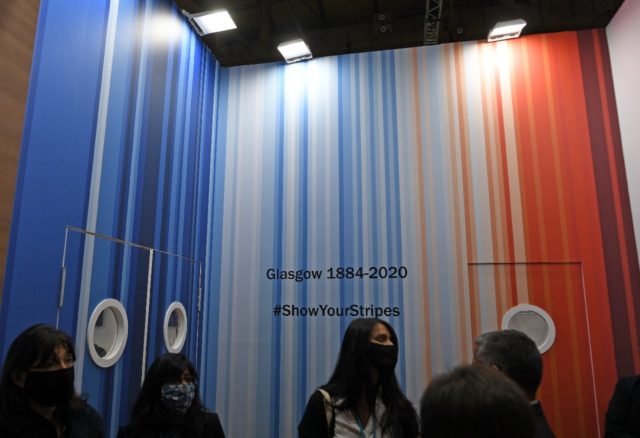A striped design showing the impact of global warming on 170 years of world temperatures at a glance has become a hit at the UN’s COP26 climate summit in Glasgow.
The lined red and blue image, which shows global average temperatures from 1850 to 2020, has been on display at the talks in exhibitions on sustainability, adorned face masks and clothes and even graced the wall of the summit’s cafeteria.
Professor Ed Hawkins, the climatologist who created the design, told AFP it was “pretty staggering” to see the image across the venue as he attended the talks in Scotland’s second city last week.
“It’s a very stark visual, which communicates very simply and very quickly the fact that the planet has warmed very rapidly,” Hawkins said at Reading University in southern England where he created the design.
The image, which has become known as the “climate stripes”, is created with one line of colour for each year going from left to right.
Blue shades indicate colder years and red tones the warmer ones.
“It’s a striking representation of how the planet has warmed, particularly over the last 30 or 40 years,” Hawkins said.
The climatologist came up with the design in preparation for a Welsh literary festival.
“I could immediately see the audience recognise what was going on,” he said.
“Many people can understand scientific graphs and axes and numbers. But many people find that difficult. And so having a range of options to communicate to different audiences is absolutely critical.”
With the help of a viral online campaign, #ShowYourStripes, Hawkins’ design has gone on to have a life of its own and has appeared at rock concerts and London Fashion Week.
While he admits this kind of exposure for his work is of a kind that “scientists don’t expect to see”, the graphic has provoked discussion in unusual places.
“We need to ensure that the climate crisis is talked about every day, it becomes part of our national conversation, because that is the way that we can get people to respond to the challenges ahead,” he said.
“And that is why it’s so great to see them being used by knitting groups or by rock bands or by fashion designers to start conversations.”

COMMENTS
Please let us know if you're having issues with commenting.